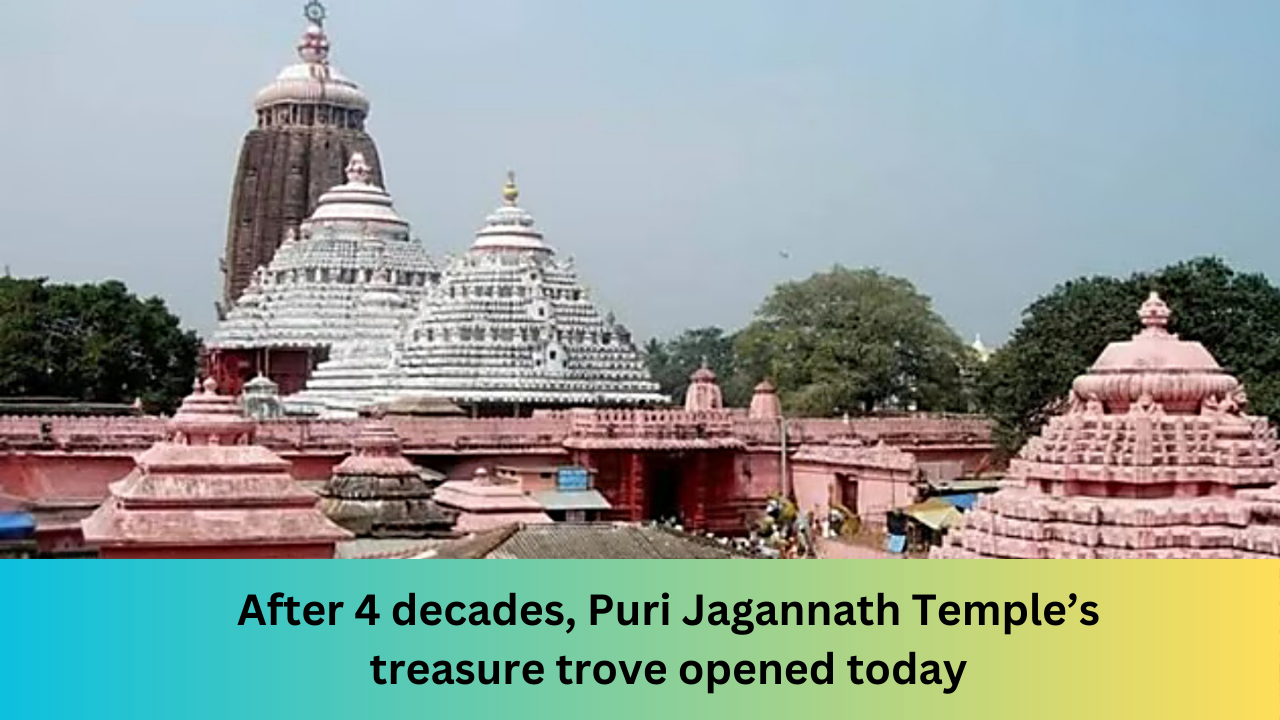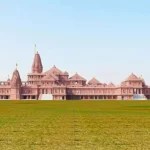The valuable ornaments of the sibling deities, Lords Jagannath and Balabhadra, as well as Goddess Subhadra, have been saved in the Ratna Bhandar of the temple that dates back to the 12th century. These decorations have been contributed by devotees and former monarchs over the course of several centuries.
For the first time in forty years, the ratna bhandar, also known as the treasure trove, of the Puri Jagannath Temple was opened to the public at 1.28 p.m. a Sunday.
In a post on X, the Chief Minister’s Office informed the public that “Today, in accordance with your (Lord Jagannath’s) wish, the Ratna Bhandar was opened after 46 years for a greater purpose.”
An eleven-person crew entered the Treasury after it had been opened for business. The team comprised the Chief Administrator of the Shree Jagannath Temple Administration (SJTA), the Puri Collector, the ASI Superintendent (Odisha circle), a member of the Ratna Bhandara sub-committee of the SJTA, two members from the supervisory panel formed by Odisha government to oversee the process, representative of Gajapati Maharaj (Puri’s erstwhile royal) and four people from the temple servitors’ community.
Years after an attempt to unlock the treasure trove was unsuccessful due to the absence of keys, the government of Odisha had once authorized a request to open the treasure trove.
This is no longer a problem with the key. The ratna bhandar will be unlocked regardless of whether or not the keys are successful in opening it. There has been a significant amount of time that has passed since the lock was opened. Iron is the material that the lock is composed of, so there is also the possibility that it will rust.
Justice Biswanath Rath, who chairs the committee that was appointed to supervise the procedure, stated that they would burst the lock if it were necessary. This statement was made one day before the Treasury was unlocked.
In the midst of rumors that serpents were guarding the riches, the authorities said that they would reach out to members of the snake helpline for their assistance. “The medical team and members of the snake helpline will not enter the temple,” the statement read. Outside of the shrine that dates back to the 12th century, they will continue to be on standby next to the temple administrative office. If it is required, we shall seek their assistance,” Justice Rath stated.
The valuable ornaments of the sibling deities, Lords Jagannath and Balabhadra, as well as Goddess Subhadra, have been saved in the Ratna Bhandar of the temple that dates back to the 12th century. These decorations have been contributed by devotees and former monarchs over the course of several centuries.
The Bhitar Bhandar, also known as the inner chamber, and the Bahara Bhandar, sometimes referred to as the outer chamber, are both located within the temple.
In spite of the fact that the outer chamber is opened on a regular basis in order to retrieve jewelry for the deities during the Suna Besha (golden clothing), which is an important ritual that takes place during the annual Rath Yatra and also during significant festivals throughout the year, the last inventory of the ratna bhandar was carried out in 2018. In 1985, when it was reopened, there was no new inventory being taken at that time.
An attempt to open the treasure trove had been made by the previous BJD government on April 4, 2018, but it had been unsuccessful. Without the keys, they were unable to unlock it, which caused indignation throughout the entire state.
A contentious topic in the run-up to the recently held Assembly elections was the inauguration of the Ratna Bhandar. The BJP, which is currently in power, has been criticizing the administration that Naveen Patnaik led in the previous year over the issue.
The Puri Jagannath Temple, one of the most revered and ancient Hindu temples, has held a significant place in Indian history and culture for centuries. Located in the coastal town of Puri in the state of Odisha, this temple is dedicated to Lord Jagannath, an avatar of Lord Vishnu. The temple is not only a major pilgrimage site but also a symbol of India’s rich heritage.
For the first time in four decades, the temple’s treasure trove has been opened, revealing a wealth of artifacts and treasures that have piqued the interest of historians, devotees, and the general public alike.
The Puri Jagannath Temple was built in the 12th century by King Anantavarman Chodaganga Deva of the Eastern Ganga dynasty. The temple’s architecture is a classic example of Kalinga style, characterized by its towering spires, intricate carvings, and robust structure. The temple complex covers an area of over 400,000 square feet and is surrounded by a high fortified wall.
The temple is primarily dedicated to Lord Jagannath, along with his siblings Balabhadra and Subhadra. It is one of the Char Dham pilgrimage sites, which are considered sacred by Hindus.
The temple’s annual Rath Yatra, or chariot festival, attracts millions of devotees from all over the world. During this festival, the deities are taken out in massive chariots, allowing the devotees to have a glimpse of them, an event that is both spiritually and culturally significant.
The treasure trove of the Puri Jagannath Temple has been a subject of legend and folklore for centuries. It is believed that the temple’s wealth was accumulated over centuries through donations from kings, devotees, and wealthy patrons. The treasure includes a variety of items such as gold and silver ornaments, precious stones, coins, and ancient artifacts.
The last recorded inspection of the temple’s treasure was conducted over four decades ago. Since then, the vaults have remained sealed due to various reasons, including security concerns, religious sentiments, and administrative issues. The decision to reopen the vaults has been a topic of debate among temple authorities, government officials, and religious leaders.
Reopening the treasure trove required meticulous planning and stringent security measures. The temple authorities, in collaboration with the state government, ensured that the process was conducted with the utmost care and respect for religious sentiments. A high-level committee comprising historians, archaeologists, and religious leaders was formed to oversee the process.
The actual process of reopening the vaults was conducted in a ceremonial manner, with priests performing rituals and prayers to seek divine blessings. The first vault to be opened revealed a dazzling array of gold and silver ornaments, intricately designed with exquisite craftsmanship.
The second vault contained ancient coins, many of which dated back to the medieval period. The third vault held precious stones, including diamonds, rubies, and emeralds.
Once the treasures were unveiled, the process of cataloging and preserving them began. Each item was meticulously documented, photographed, and analyzed by experts. The state government has assured that the treasures will be preserved in a secure environment, with plans to display some of the items in a museum for public viewing.
The reopening of the treasure trove offers a unique opportunity to gain insights into the historical and cultural heritage of the region. The artifacts and ornaments provide valuable information about the craftsmanship, trade, and economic conditions of ancient Odisha. The coins, in particular, are expected to shed light on the monetary systems and trade practices of the time.
For devotees, the reopening of the treasure trove is a momentous occasion. It reaffirms the temple’s status as a center of wealth and prosperity, believed to be bestowed by Lord Jagannath himself. The event has also sparked a renewed interest in the temple’s history and its significance in the Hindu faith.
The treasures, once properly documented and preserved, have the potential to boost tourism in Puri. The state government plans to develop a museum that will display selected items from the treasure, attracting tourists and scholars from around the world. This, in turn, is expected to have a positive impact on the local economy.
The reopening of the treasure trove has raised concerns about security. Ensuring the safety of the treasures is paramount, and the temple authorities, along with the state government, have implemented stringent security measures. This includes round-the-clock surveillance, security personnel, and advanced security systems.
The decision to reopen the vaults has not been without controversy. Some religious leaders and devotees believe that the treasures should remain untouched, as they are considered divine offerings to the deity. The temple authorities have tried to address these concerns by involving religious leaders in the process and ensuring that the treasures are handled with the utmost respect.
The reopening of the treasure trove has also faced legal and administrative challenges. The temple is managed by the Shree Jagannath Temple Administration (SJTA), which operates under the jurisdiction of the state government. Ensuring that the process adheres to legal requirements and managing the coordination between various stakeholders has been a complex task.
One of the primary focuses moving forward will be the preservation of the treasures. Experts in conservation and restoration will be involved in ensuring that the artifacts are preserved for future generations. Additionally, the treasures will provide a wealth of material for research, offering new insights into the history and culture of the region.
The state government and temple authorities plan to leverage the treasures for educational purposes. This includes developing exhibitions, educational programs, and publications that will help disseminate knowledge about the temple’s history and its treasures. Collaborations with universities and research institutions are also being considered.
The reopening of the treasure trove is expected to enhance the pilgrimage experience for devotees. Plans are underway to develop guided tours and interactive exhibits that will allow pilgrims to learn about the history and significance of the treasures. This will add a new dimension to the spiritual journey of the devotees.
The reopening of the Puri Jagannath Temple’s treasure trove is a landmark event that has captivated the attention of people across the world. It offers a unique opportunity to explore the rich history and culture of the region, while also presenting challenges in terms of preservation and security.
As the treasures are documented, preserved, and displayed, they are expected to provide valuable insights into the past and contribute to the cultural and economic development of the region. The event reaffirms the temple’s significance as a center of faith, wealth, and heritage, continuing to inspire awe and reverence among devotees and scholars alike.











